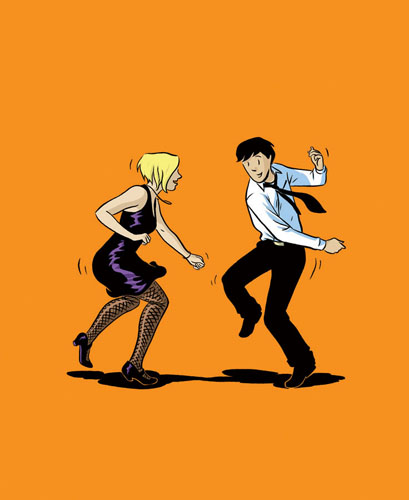In honour of my long-weekend getaway to Montreal, and today's Twitter follow from
Conundrum Press, I'm republishing a piece I wrote a few years back that originally appeared on
rabble.ca.
Set against a backdrop of urban Montreal,
The Hipless Boy is a collection of 45 semi-autobiographical short stories by Sully, the pen name of poet, graphic novelist and illustrator Sherwin Tjia. Originally a weekly column in the
McGill Daily, The Hipless Boy introduces readers to Tjia's protagonist, aptly named Sully, who is your typical sketch-book carrying, sushi-eating, poetry-writing urbanite who grapples with his surroundings, feeling alien in a neighbourhood dominated by noisy nightclubs and girls in stilettos.
Tjia admittedly
blends his real life with fiction, creating a funny and charming example of a graphic novel for adults. He is one of a growing number of artists sharing their own experiences in graphic form, including Adrian Tomine, David Small, Montreal's Julie Doucet and, of course, Marjane Satrapi, whose illustrated tales of her Iranian childhood have garnered acclaim all over the world.
In
The Hipless Boy, Montreal's streetscapes bubble from Tjia's black, white and blue illustrations. The city acts as a fourth character, mingling alongside Sully and his platonic best friend, Minerva, and Owen, a visual artist whose attempts to be creative are usually offensive, making him an often unlikeable character.
Sully, as both a character and a writer, is remarkably observant, finding beauty and absurdity in the mundane, whether the subject of his story is a pigeon fighting for food, or a seemingly ill-tempered stranger on a bus. "The spectacularly bizarre things that actually happen to people is a continual and joyful surprise," Tjia writes. Unfortunately, Sully isn't always introspective, leaving readers to feel slightly disconnected from him, especially as he tackles tough issues, such as love and even a friend's suicide.
The Hipless Boy's appeal seems to lie in the contrast between the ordinary and unusual situations — going on dates to coffee shops, riding the bus to and from his day job and feeding pigeons in a park — he is also surprisingly open to new experiences, such as moonlighting as a "recreational cross dresser," showing readers that he's more in place in his hip neighbourhood than even he himself realizes.
Tjia's talent as both a visual artist and a writer are evident from the first page of
The Hipless Boy, as his clean, crisp writing compliments his simple, yet detailed illustrations. Among the many accolades Tjia has received since
The Hipless Boy was published last year, is a nomination for a coveted
Doug Wright Award in the category of best emerging talent. The winners will be announced during the
Toronto Comic Arts Festival on May 8. Even if readers can't relate to Sully or his non-conformist friends, readers, especially those living in large urban centres like Montreal, will appreciate Tjia's talent for capturing the ordinary shifting of urban living, recognizing the monotony, absurdities and unexpectedness of daily life. —Jessica Rose







